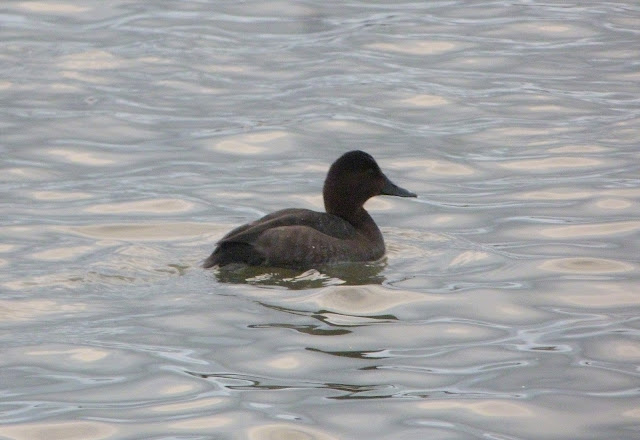Waterfowl...
Canada Geese were present daily with a peak of 250 on the 20th; Brent Geese were seen on four dates (all 'Russian Brants' aka 'Dark-bellied Brent Geese'), with a peak of 12 on the 10th; whilst Barnacle Geese were seen on two dates, with 13 on the 10th and 11 on the 17th.
Over 400 Mute Swans were present throughout; whilst the four Whooper Swans were also present virtually daily; and a Black Swan was also present throughout.
 |
Whooper Swans, Abbotsbury Swannery, December 2020 © Steve Groves |
Shelducks were present throughout with a peak of at least 25 on the 20th.
All the expected dabbling ducks were present, with peak counts of 130 Shoveler; 3 Gadwall; 100 Wigeon; 225 Mallard; 150 Pintail; and 450 Teal.
All the usual diving ducks were noted too, with peak counts of 220 Pochard; 150 Tufted Duck; 4 Scaup; and 5 Red-breasted Merganser. In addition three (first calendar year) Long-tailed Ducks were seen briefly on the 8th and 9th.
 |
Scaup (1cy drake), Abbotsbury Swannery, December 2020 © Charlie Wheeler |
 |
Scaup (ad. duck), Abbotsbury Swannery, December 2020 © Charlie Wheeler |
 |
Long-tailed Ducks (1cy duck, 2 1cy drakes), Abbotsbury Swannery, December 2020 © Kevin Butler |
The highlight though was a Ferruginous Duck (a first calendar year) found on the 7th (the first since December 2009). It was not present the next two days but reappeared on the 10th and was then seen virtually daily to the 31st (although it wasn't always easy to find even from the grounds). Due to ongoing Avian Influenza and Corona Virus restrictions and the fact it could not be easily seen (if at all) from public rights of way, the decision was made heavyheartedly to not release the news of it's reappearance (until now).
 |
Ferruginous Duck, Abbotsbury Swannery, December 2020 © Steve Groves |
 |
Ferruginous Duck, Abbotsbury Swannery, December 2020 © Steve Groves |
 |
Ferruginous Duck, Abbotsbury Swannery, December 2020 © Steve Groves |
 |
Ferruginous Duck, Abbotsbury Swannery, December 2020 © Steve Groves |
Shorebirds...
The only Oystercatcher was seen on the 7th; whilst Lapwings were present throughout peaking at 500 on the 25th.
Two Black-tailed Godwits were present on the 2nd; eight Turnstones were seen on the 10th, followed by a single on the 10th; a Knot was seen on the 10th; single Dunlins were noted on three dates; Snipe were present throughout, with a peak of 30 on the 29th; singles of both Common Sandpiper and Green Sandpiper were again seen regularly; whilst Redshanks were present throughout with a peak of five on the 1st.
Gulls...
The three regular small gulls were all seen daily with peak counts of over 500 Black-headed Gulls on the 26th, over 500 Mediterranean Gulls on the 21st and over 1,000 Common Gulls also on the 21st. The three regular large gulls were all seen virtually daily too with a peak counts of over 200 Herring Gulls on the 21st and over 10 Great Black-backed Gulls on the 14th. Lesser Black-backed Gulls though were only ever noted in low single figures.
Other Waterbirds...
Water Rails, Moorhens and Coots were all present throughout, with a peak count of 180 of the latter on the 29th.Both Little Grebes and Great Crested Grebes were present throughout, with a peak of at least 14 of the former on the 11th and at least 10 of the latter on several dates.
Cormorants were present throughout, with at least 20 in the roost nightly.
Cattle Egrets continued to roost nightly, with a peak count of 29 on the 25th; There were also of course daily sightings of Little Egrets, with at least 10 present on the 7th; and Grey Herons, with at least three present on the 1st.
Single Kingfishers were seen regularly.
Hawks, Owls & Falcons...
Single Marsh Harriers were seen regularly but with two present on three dates: whilst single figures of Buzzards were seen daily.
A Barn Owl was seen on the 1st, followed by two on the 8th; whilst a Tawny Owl was heard on the 3rd, although both species were almost certainly present throughout.
Kestrels were present in single figures daily but single Peregrines were seen on three dates only.
Other Non-passerines...
Pheasants, Feral Pigeons, Wood Pigeons and Collared Doves were all relatively numerous throughout, whilst singles of Great Spotted Woodpecker and Green Woodpecker were both seen regularly too.
Passerines...
Magpie, Jackdaw, Rook and Carrion Crow were all relatively numerous throughout; Ravens were seen in single figures regularly; whilst single Jays were noted on two dates.
Coal Tit, Blue Tit, Great Tit and Long-tailed Tit were all relatively numerous throughout, as were Cetti's Warblers, Chiffchaffs, Goldcrests and Wrens.
The nightly Starling roost was rather unimpressive, peaking only at around 200 on the 17th.
Blackbirds and Song Thrushes were both relatively numerous throughout but Redwings and Fieldfares were scarce with only one of the former noted on the 2nd, followed by two on the 21st and just one of the latter noted on the 2nd only.
Dunnocks, Robins and Stonechats were all relatively numerous throughout; as were Skylarks, Meadow Pipits and Pied Wagtails; whilst single Rock Pipits and Grey Wagtails were seen regularly too.
House Sparrows, Reed Buntings, Chaffinches and Goldfinches were all relatively numerous throughout, with a good count of over 50 of the latter on the 12th. Greenfinches were seen fairly regularly but only in single figures, with a peak of five on several dates (sadly 50 would be the norm not that long ago). The only Linnets were a few heard on the 8th (scarce here in winter) and the only Bullfinch was seen on the 29th.
... And that's it for this post except to thank Alan Barrett, Kev Butler, Joe Stockwell, and Charlie Wheeler for their sightings and where applicable for the use of their photos.
January 2021 sightings to follow shortly.
Steve Groves.
Steve Groves.



This comment has been removed by a blog administrator.
ReplyDelete